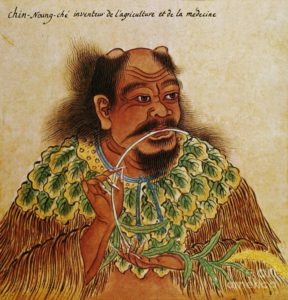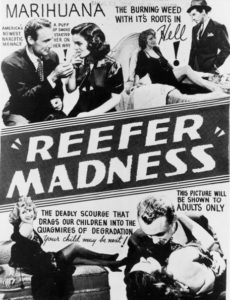6000-Year Documented History of Cannabis
This timeline highlights the documented history of cannabis throughout the world. Follow along as we take you back through time to take a look at how Cannabis has remained an important plant in many cultures around the world. It’s only recently (over the last 80 years) that Cannabis has received a bad reputation and been classified as an illegal drug. Hemp being apart of the same (Cannabis Sativa L) family, was also made illegal even though no psychoactive effect can be achieved, or instigated with its use. Hemp has been cultivated for millions of years for the many products it can be used for.

Our journey goes back to the beginning of time...
4000 BC: Pan-p’o village
Cannabis was regarded among “five grains” in China, and was farmed as a major food crop. China is known as having one of the first documented history of cannabis.
4000 BC2737 BC: Pen Ts’ao Ching
Earliest record of cannabis as a medicinal drug. At this time, Emperor Shen-Nung recognized its
treatment properties for over 100 ailments such as gout, rheumatism, and malaria.

2000-1400 BC: Scythians
Nomadic Indo-European peoples used cannabis in steam baths, and also burned cannabis seeds in burial rituals.
Further reading: These 2,400-year-old solid-gold bongs were used by Scythians for cannabis by TheCannabist.co
2000-1400 BC2000-1000 BC: Atharva Vedas
As the documented history of cannabis continues, it was described as a “source of happiness”, “joy-giver”, and “bringer of freedom” in these Hindu religious texts. At this time, cannabis was smoked at daily devotional services and religious rituals.
2000-1000 BC2000-1000 BC: Ayurvedic Medicine
Open religious use of cannabis allowed for exploration of medical benefits. During this period, it was used to treat a variety of ailments such as epilepsy, rabies, anxiety, and bronchitis.
2000-1000 BC1550 BC: Ebers Papyrus
Egyptian medical papyrus of medical knowledge notes that medical cannabis can treat inflammation.
1550 BC1213 BC: Ramesses II
Cannabis pollen has been recovered from the mummy of Ramesses II, the Egyptian pharaoh who was mummified after his death in 1213 BC.
1213 BC900 BC: Assyrians
Employed the psychotropic effects of cannabis for recreational and medical purposes.
900 BC450-200 BC: Greco-Roman use
Physician Dioscorides prescribed cannabis for toothaches and earaches. Greek doctor Claudius Galen noted it was widely consumed throughout the empire. Women of the Roman elite also used cannabis to alleviate labor pains.

207 AD: Hua T’o
First recorded physician to describe cannabis as an analgesic. He used a mixture of cannabis and wine to anesthetize patients before surgery.
207 AD1000 AD: Treats Epilepsy
Arabic scholars al-Mayusi and al-Badri regard cannabis as an effective treatment for epilepsy.
1000 AD1025 AD: Avicenna
The medieval Persian medical writer publishes “Avicenna’s Canon of Medicine”, stating that cannabis is an effective treatment for gout, edema, infectious wounds, and severe headaches. His work was widely studied from the 13th to 19th centuries, having a lasting impact on Western medicine. This influence, further adds to the medically documented history of cannabis.
1025 AD1300 AD: Arab traders
Arab traders bring cannabis from India to Eastern Africa, where it spreads inland. It is used to treat malaria, asthma, fever, and dysentery.
1300 AD1500 AD: Spanish Conquest
The Spanish brought cannabis to the Americas, where it was used for more practical purposes like rope or clothes. However, years later, it would be used as a psychoactive and medicinal drug.
1500 AD1776: The Founding Fathers
One of the most noteworthy documented history of cannabis in America started after America became independent. It became the law that every farmer must grow hemp, in the interests of national security, for the army had no garments and rope, while the navy could not set sail. The Founding Fathers - Thomas Jefferson, Ben Franklin and George Washington had large hemp plantations!

1798: Napoleon Bonaparte
Napoleon brought cannabis back to France from Egypt, and it was investigated for its pain relieving and sedative qualities. At this time, cannabis would be used to treat tumors, cough, and jaundice.
17981839: Willian O'Shaughnessy
Irish doctor William O’Shaughnessy introduced the therapeutic uses of cannabis to Western
medicine. He concluded it had no negative medicinal effects, and the plant’s use in a pharmaceutical context would rapidly rise thereafter. Until the 1880’s almost all paper in the United States was made of Hemp. Hemp served as an organic currency between 1631 and the early 1800s, when individuals used it to pay their taxes.

1840-1900: Bristol-Meyer's Squib & Eli Lilly
Prior to 1910, “marijuana” didn’t exist as a word in American culture. Rather, “cannabis” was used, most often in reference to medicines and remedies for common household ailments. In the early 1900s, what have now become pharmaceutical giants—Bristol-Meyer’s Squib and Eli Lilly—used to include cannabis and cannabis extracts in their medicines. During this time, Americans (particularly elite Americans) were going through a hashish trend. Glamorized by literary celebrities such as Alexander Dumas, experimenting with cannabis products became a fad among those wealthy enough to afford imported goods.

1900: Medical Cannabis
Medical cannabis was used to treat nausea, rheumatism, and labor pain. At this point in time, it is available over-the-counter in medications such as “Piso’s cure” and “One day cough cure”.
19001913: Criminalization
The first bill criminalizing the cultivation of “locoweed” was passed in California. The bill was a major push from the Board of Pharmacy as a way to regulate opiates and psychoactive pharmaceuticals, and seemingly did not stem from the “reefer madness” or racialized understanding of “marijuana” that paved the way to full-on prohibition in the 1930s.
19131914: Harrison Act
Drug use was declared a crime in the U.S., under the Harrison Narcotics Tax Act in 1914.
19141930s: Great Depression
The Great Depression had just hit the United States, and Americans were searching for someone to blame. Due to the influx of immigrants (particularly in the South) and the rise of suggestive jazz music, many white Americans began to treat cannabis (and, arguably, the Blacks and Mexican immigrants who consumed it) as a foreign substance used to corrupt the minds and bodies of low-class individuals. In the time just before the federal criminalization of the plant, 29 states independently banned the herb that came to be known as “marijuana.”
19301930's: Harry Anslinger
It would not be an overstatement to say that Harry Anslinger was one of the primary individuals responsible for creating the stigma surrounding cannabis. Hired as the first director of the recently created Federal Bureau of Narcotics in 1930, Anslinger launched a vigilante campaign against cannabis that would hold steady for the three decades he remained in office. A very outspoken man, Anslinger used the recent development of the movie theater to spread messages that racialized the plant for white audiences. In one documented incident, Anslinger testified before Congress, explaining: “Marijuana is the most violence-causing drug in the history of mankind… Most marijuana smokers are Negroes, Hispanics, Filipinos and entertainers. Their satanic music, jazz and swing, results from marijuana usage.” In another statement, Anslinger articulated: “Reefer makes darkies think they’re as good as white men…the primary reason to outlaw marijuana is its effect on the degenerate races.” In retrospect, Anslinger’s efforts with the Bureau of Narcotics were the reason “marijuana” became a word known by Americans all over the country. When making public appearances and crafting propaganda films such as Reefer Madness, Anslinger specifically used the term
“marijuana” when campaigning against the plant, adding to the development of the herb’s new “foreign” identity. Cannabis was no longer the plant substance found in medicines and consumed unanimously by American’s all over the countrythe herb that came to be known as “marijuana.”

1937: Marihuana Tax Act
The Marihuana Tax Act banned the use and sales of cannabis in the United States. (Before that it was completely legal to own, sell, and ingest.)outspoken man, Anslinger used the recent development of the movie theater to spread messages that racialized the plant for white audiences. In one documented incident, Anslinger testified before Congress, explaining: “Marijuana is the most violence-causing drug in the history of mankind… Most marijuana smokers are Negroes, Hispanics, Filipinos and entertainers. Their satanic music, jazz and swing, results from marijuana usage.” In another statement, Anslinger articulated: “Reefer makes darkies think they’re as good as white men…the primary reason to outlaw marijuana is its effect on the degenerate races.” In retrospect, Anslinger’s efforts with the Bureau of Narcotics were the reason “marijuana” became a word known by Americans all over the country. When making public appearances and crafting propaganda films such as Reefer Madness, Anslinger specifically used the term
“marijuana” when campaigning against the plant, adding to the development of the herb’s new “foreign” identity. Cannabis was no longer the plant substance found in medicines and consumed unanimously by American’s all over the countrythe herb that came to be known as “marijuana.”

1937: Marihuana Tax Act Continued
The Marihuana Tax Act of 1937 was the culmination of Anslinger’s work and the first step to all-out prohibition. The bill federally criminalized the cannabis plant in every U.S. state. In order to discourage the production of cannabis use, the Tax Act of 1937 placed a one dollar tax on anyone who sold or cultivated the cannabis plant. On top of the tax itself, the bill mandated that all individuals comply with certain enforcement provisions. Violation of the provisions would result in imprisonment and/or a fine of up to $2,000. Though the word “marijuana” is the most common name for cannabis in the United States today, its history is deeply steeped in race, politics, and a complicated cultural revolution. Some argue that using the word ignores a history of oppression against Mexican immigrants and African Americans, while others insist that the term has now lost its prejudiced bite. Regardless
of whether or not you decide to use the word yourself, it’s impossible to deny the magnitude and racial implications of its introduction to the American lexicon. “marijuana” when campaigning against the plant, adding to the development of the herb’s new “foreign” identity. Cannabis was no longer the plant substance found in medicines and consumed unanimously by American’s all over the countrythe herb that came to be known as “marijuana.”
1964: Discovery of THC
The molecular structure of THC, an active component of cannabis, was discovered and
synthesized by Israeli chemist Dr. Raphael Mechoulam. provisions. Violation of the provisions would result in imprisonment and/or a fine of up to $2,000. Though the word “marijuana” is the most common name for cannabis in the United States today, its history is deeply steeped in race, politics, and a complicated cultural revolution. Some argue that using the word ignores a history of oppression against Mexican immigrants and African Americans, while others insist that the term has now lost its prejudiced bite. Regardless of whether or not you decide to use the word yourself, it’s impossible to deny the magnitude and racial implications of its introduction to the American lexicon. “marijuana” when campaigning against the plant, adding to the development of the herb’s new “foreign” identity. Cannabis was no longer the plant substance found in medicines and consumed unanimously by American’s all over the country the herb that came to be known as “marijuana.”

1970: Classified as Schedule 1 Drug
Cannabis became categorized as a Schedule 1 Drug in the U.S., which limited further research into the plant. It was listed as having “no accepted medical use”.
19701988: CBD Receptors Discovered
The CBD1 and CBD2 cannabinoid receptors were discovered. Today, we know they are some of the most abundant neuroreceptors in the brain.
19702000-2018: Medical cannabis legalization
Governments, such as those of Canada and various states, begin to legalize cannabis for
medical purposes from licensed producers. Recreational legalization quickly starts to follow.
Thank you for following along this timeline of the documented history of cannabis.
Please visit this page again as we continue to add more important dates and progress.

